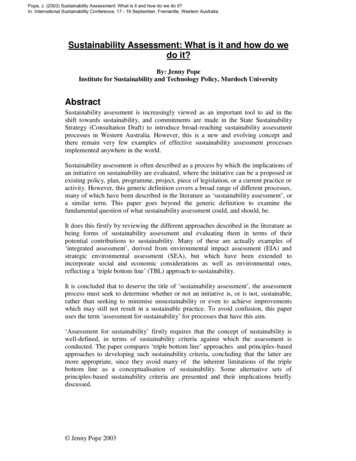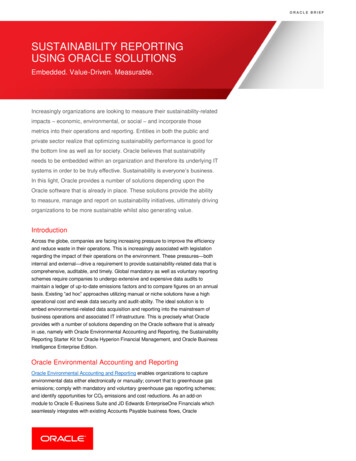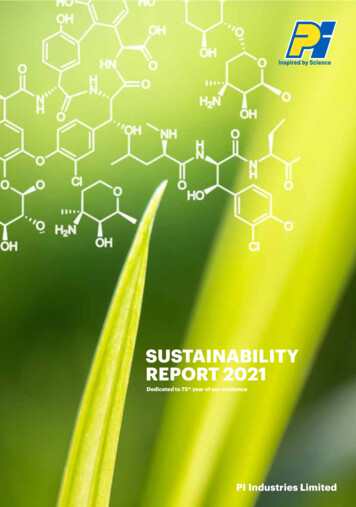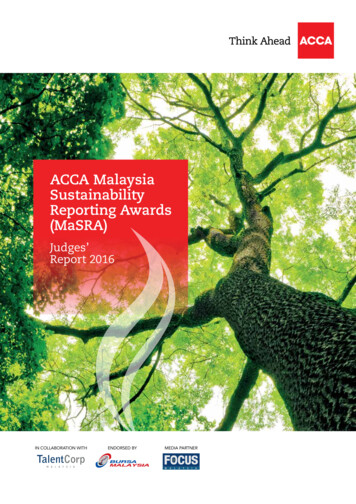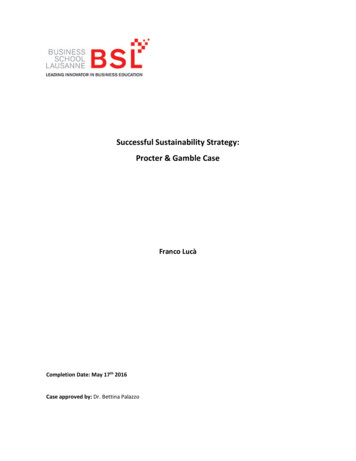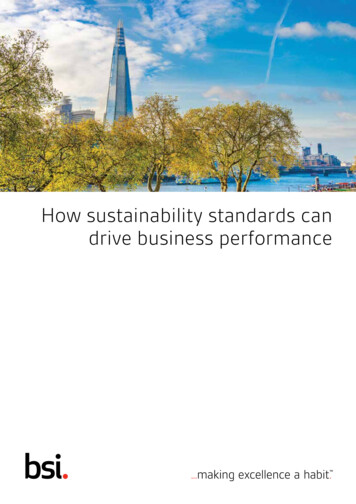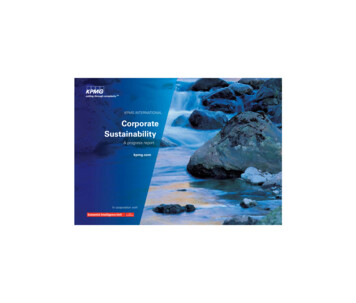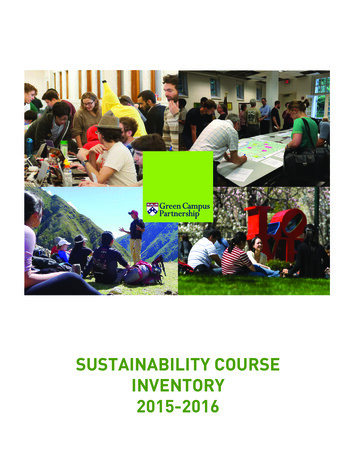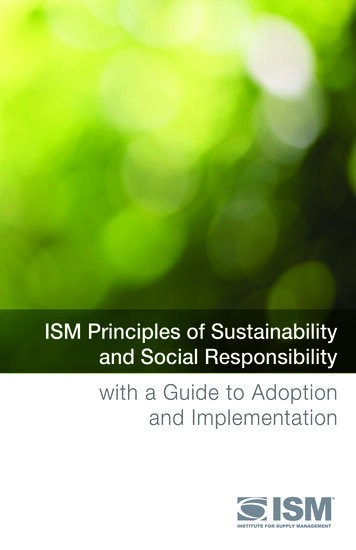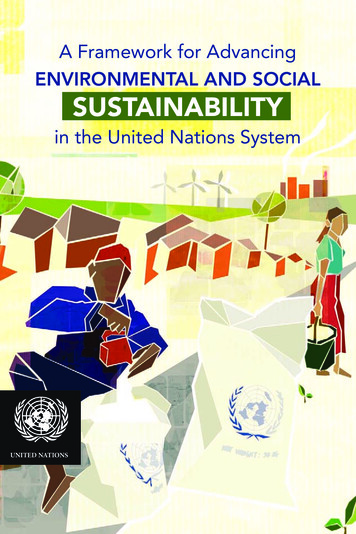
Transcription
A Framework for AdvancingENVIRONMENTAL AND SOCIALSUSTAINABILITYin the United Nations SystemUNITED NATIONS
2012 United NationsAll rights reserved worldwideRequests to reproduce this publication in whole or in part should be sent to permissions@un.org.DisclaimerThe designations employed and the presentation of the material in this publication do not imply the expression of any opinion whatsoever on the part of the United Nations concerning the legal status of any country,territory, city or area or of its authorities, or concerning delimitation of its frontiers or boundaries. Mention ofa commercial company or product does not imply endorsement by the cooperating partners. The views expressed do not necessarily represent the decision or the stated policy of the United Nations nor does citing oftrade names or commercial processes constitute endorsement.Printed on recycled paper.
A FRAMEWORK FOR ADVANCINGENVIRONMENTAL AND SOCIALSUSTAINABILITYIN THE UNITED NATIONS SYSTEMPrepared by Environment Management GroupUnited Nations, Geneva, 2012
Table of Content:Foreword6Preface7Joint Statement by Executive Heads of EMG Members9Executive summary10Introduction12Chapter 1 –17Towards a common environmental and social sustainability framework25Chapter 2 –Context for a system-wide environmental and social sustainability framework33Chapter 3 –Key findings from the inter-agency review on environmentaland social sustainability43Chapter 4 –Future considerations for a common environmentaland social sustainability frameworkAnnex A:49Annex B:51Annex C:55Annex D:57Annex E:58Annex F:64Minimum requirements for a system-wide environmentaland social sustainability frameworkUnited Nations entities and institutions employing sustainability systemsWorld Health Organization case study:Development of an environmental and social sustainability systemList of review intervieweesExamples of the founding documents and principlesof existing environmental and social sustainability systemsContributorsAbbreviations and AcronymsMembership of the Environment Management Group5
ENVIRONMENTAL AND SOCIAL SUSTAINABILITYForewordby the United Nations Secretary-GeneralThe global population has reached 7 billion. In just five years, we will add another halfbillion people – all needing food, jobs, security and opportunity. Yet environmental,economic and social indicators tell us that our current model of progress cannot bemaintained.Sustainable development offers the best chance to adjust our course. That will meandoing far more to connect the dots among the main challenges the world facestoday: water, food and energy security, climate change, poverty, inequality and theempowerment of the world’s women.United Nations agencies, funds and programmes are working to create a sustainablefuture – the future we want. But even as we dispense aid and advice to others, wehave to recognize that we, too, are part of the picture. How we make policy, developprogrammes and oversee our facilities must also be viewed through the lens ofsustainability.This report is the product of inter-agency consultations aimed at ensuring greaterenvironmental and social sustainability in our work. The report notes that while manyindividual United Nations entities have adopted assessment policies and practices, theUnited Nations System acting together can do even more, including by developing acommon sustainability framework and relevant indicators.A Framework for Advancing Environmental and Social Sustainability in the UnitedNations System will greatly assist in this effort. It coincides with the run-up to theRio 20 United Nations Conference on Sustainable Development, a major opportunityto reinvigorate this cause. And it follows the January 2012 release of the report ofmy Global Sustainability Panel, which has put forward a wide range of importantrecommendations, including to strengthen the United Nations System’s own sustainabledevelopment strategy.Internalizing environmental, social and economic sustainability practices can makeus a more efficient, effective and responsible organization.I am strongly committed to this agenda and look forwardto working with all partners within and beyond the UnitedNations to achieve a sustainable and equitable future for all.Ban Ki-moonUnited Nations Secretary-General6
Prefaceby the Chair of the Environment Management GroupIn order to meet the environmental, social and economic challenges of a new century theUnited Nations needs to find improved ways of identifying the full benefits and costs ofthe decisions it takes.The United Nations has a long history of advocating for environmental and socialresponsibility: this is now evolving into a unifying platform that will strengthen thesustainability of its administrative and operational choices. For the past two years aninter-agency initiative to advance environmental and social sustainability in the UnitedNations System has been exploring this issue, under the guidance of the EnvironmentalManagement Group.This report backed up by a Sustainability Framework will allow the United Nations tobroaden its traditional and sometimes isolated ways of working in order to betterunderstand how the complex suite of activities taken across the organization influenceone another in terms of impacts and outcomes.The Environmental and Social Sustainability initiative will in addition assist the UnitedNations to collectively measure progress towards sustainability as an institution, andto better see the risks and opportunities. It also allows us to learn from each other’sexperiences, capture institutional knowledge and work together for the results required.A system-wide approach will ensure a United Nations-wide commitment to integratesimultaneous economic, environmental and social impact assessments in major policyand decision-making processes. No other international institution has put forth anenvironmental and social assessment initiative as holistic and inclusive as this one.Rio 20 under the themes of a Green Economy in the context of sustainable developmentand poverty eradication and an institutional framework for sustainable development is anopportunity for the United Nations to exhibit its commitment and leadership in taking thiseffort forward.This is a work in progress. Some of the next steps include the inter-agency processcontinuing its consultative work. This will focus on evolvingthe policy-level framework into an implementation phase thatall United Nations entities can take forward in a flexible andphased approach.To be a credible institution, what we ask of others, we mustdo ourselves. To be a leader, we must go further and supportways in which we can continuously learn from our work andeach other.Achim SteinerExecutive Director, Environment Management Group7
UN Photo / Logan AbassiENVIRONMENTAL AND SOCIAL SUSTAINABILITYHaitian students breathe new life into depleted pine forest, Haiti.8
Joint Statement by Executive Heads of EMG Memberson Advancing Environmental and Social Sustainabilityin the United Nations SystemWe, the Executive Heads of Agencies, Funds, Programmes and Departments of the UnitedNations,Are convinced that the promotion of human well-being and global sustainability hinges onenvironmental protection and social and economic development,Bear in mind the responsibility of the United Nations System to embody the internationallyaccepted environmental and social principles in its internal management as well as to supporttheir application by partners and stakeholders; and the need to reduce risks and unintendednegative impacts, and maximize benefits to people and their environment in a coherent andintegrated way within the United Nations System,Are conscious of the efforts by those United Nation System entities that have alreadydeveloped environmental and social safeguards to mitigate the environmental and socialimpacts and risks of their activities before the adoption of a common approach to advancingenvironmental and social sustainability in the United Nations System,Are mindful of the need for the United Nations System to internalize the internationallyagreed norms of the sustainability agenda at the level of policy/strategy, programme/projectand facilities/operations management through a common framework for environmental andsocial sustainability, including through safeguards, risk management, institutional learning,capacity-building, simplification, coherence and transparency,Are recognizing the wealth of experience across the United Nations System to ensurethe environmental and social impacts and risks of activities are well managed, which hasinformed the development and adoption of this common approach,We hereby commit ourselves, proceeding in a phased manner, to use the Framework forAdvancing the Environmental and Social Sustainability in the United Nations System annexedto this statement (see chapter 1) as a means of furthering the organization’s sustainabilityperformance, including by: Moving our respective organizations towards strengthening environmental and socialsustainability in our activities, and endeavouring to find the necessary resources to realize the increased efficiency and operational safety gains of such a common approach. Supporting the further development and implementation of a United Nations Systemwide framework for environmental and social sustainability including environmental andsocial safeguards; for monitoring collective efforts; and for reporting back to the GoverningBodies of our respective organizations on progress made, good practice and lessonslearned.We make this commitment with a view to show leadership by increasing institutional accountability for the environmental and social sustainability of our activities. We do this to furtherenable the United Nations System to work smarter and safer, respond more effectively toemerging issues and stakeholder needs and better harness lessons from shared experience.9
ENVIRONMENTAL AND SOCIAL SUSTAINABILITYExecutive SummaryThe Environmental and Social Sustainability Framework strives to carry the institutionbeyond the typical safeguard measures of “do no harm” to identify ways to “do good”. Inthe spirit of One United Nations, the Framework takes a holistic view of the organization’swork from policy conception through programme implementation and internal operationsmanagement, providing a broader base of knowledge for smart decision-making. Theinitiative looks to build on the internationally agreed sustainability norms and principles ofthe last 30 years by adapting the best practices of environmental and social assessmentprocedures and management systems to United Nations System activities.This effort started when the Senior Officials of the Environment Manager Group (EMG)decided at their fifteenth1 meeting in September 2009 to undertake a consultative processand prepare a report that outlines options for a common United Nations System approachfor “environmental and social safeguards”. The opportunity to explore options foradvancing United Nations sustainability was welcomed in response to several requestsraised by EMG members in the lead-up to the meeting. The EMG initiative is in the spirit ofthe 2005 World Summit outcomes on system-wide coherence and actions to strengthenlinkages between the normative and operational work of the United Nations.The Safeguards Working Group focal points subsequently decided to change theterminology from “environmental and social safeguards” to “environmental and socialsustainability framework” as the latter encompasses safeguards plus additional measuresused in internal management practices and normative activities. In this way “sustainabilityframework” is more inclusive of United Nations System activities.The rationale for this work stems from the understanding that the systematic use ofan environmental and social sustainability framework across United Nations entitieswould provide the United Nations System with an important opportunity to demonstrateleadership, and enhance accountability for the environmental and social sustainability ofthe United Nations System policies and practices.The framework would therefore improve the quality and results of United Nationssupported activities and will help identify opportunities to harness greater efficiencies andcost savings. Operational and technical performance will be measurably enhanced, andupstream (high-level) opportunities to harness efficiencies, for instance at the level ofpolicy and programme design, will be more informed. Unforeseen environmental andsocial impacts and risks (and associated reputational liabilities and costs) can be avoided,and opportunities to leverage/maximize the positive impacts of policies, programmes/projects and operational activities can be more consistently harnessed.An inter-agency review, conducted as part of this consultation, found that the applicationof environmental and social sustainability measures by United Nations organizationsis uneven. Several entities within the United Nations System are already utilizingenvironmental and social sustainability measures such as safeguards. These practicesare not, however, consistent or readily comparable.1 EMG 15 Meeting Report10
In the absence of a common framework, United Nations organizations have adoptedmyriad ways of considering social and environmental impacts. A few organizations havedeveloped comprehensive environmental and social impact assessment procedures. Manyuse a mix of review committees and staff expertise to examine environmental and socialimplications. Overall understanding within individual organizations about the relevance (andutility) of environmental and social sustainability measures is highly varied. On one end of thespectrum, some staff members felt that the United Nations is behind the curve and needs tocatch up with its sister organizations such as the World Bank, while at the same time settinga precedent for social issues such as human rights that are not well covered by others. Onthe other end, some staff members felt that environmental and social safeguards were notrelevant to their work and that the adoption of a common approach could be a burden tothem. The confusion over the term “safeguards” was one of the reasons the approach wasreframed as an environmental and social sustainability framework that is more flexible andinclusive of United Nations activities.The importance of environmental and social safeguards measures was recognized by thesenior officials of the EMG, who initially requested the consultative process on safeguards,2and has continued to support the effort. The United Nations Environment Programme (UNEP)Governing Council at its twenty-sixth session in February 2011 also encouraged the EMG toput in place a process for environmental impact assessment and the use of environmentaland social safeguards in respect of projects taken up directly by the organizations of theUnited Nations System.A framework for environmental and social sustainability across the United Nations Systemhas been developed by the safeguards consultative process for consideration. The frameworkproposes a common vision, rationale and objective; individual actions to be taken by eachUnited Nations entity to internalize environmental and social sustainability measures; andcollective actions for the system to undertake, such as a support and knowledge-sharingfunction, minimum requirements and a centralized reporting structure.Key benefits of a common sustainability framework fall into the following five categories:capacity-building for all United Nations organizations; increased credibility; minimizingrisks and maximizing opportunities; greater simplification and coherence of policies andprocedures; and enhanced transparency.There is still a need to raise awareness and support across United Nations entities for the use ofa common environmental and social sustainability framework, and to continue the consultativeprocess to explore implementation considerations further. To be effective, the adoption of acommon framework requires high-level institutional commitment and support as set out in theStatement by Executive Heads ofAgencies, Funds, Programmes and Departments of the UnitedNations on advancing environmental and social sustainability in the United Nations System.Further work is needed to develop the policy-level framework into an implementation planand operational model that can be adapted and used by individual United Nations entities,including through the EMG work stream currently handled by the Issue Management Groupon Environmental Sustainability Management. Some of the elements that require moreconsideration and consultation include weighing options of flexibility and accountability;common and individual policies and procedures; legal and managerial requirements; andthe use of national systems.2 EMG 16 Meeting Report11
ENVIRONMENTAL AND SOCIAL SUSTAINABILITYIntroductionThis report responds to the request made by the Senior Officials of the EnvironmentManager Group (EMG) at their fifteenth3 meeting in September 2009 to undertake aconsultative process and prepare a report that explores options for a common UnitedNations System approach for “environmental and social safeguards”, now called “anenvironmental and social sustainability framework”. The opportunity to explore optionsfor advancing United Nations sustainability was welcomed in response to severalrequests raised by EMG members in the lead-up to the meeting. The EMG initiative is inthe spirit of the 2005 World Summit outcomes on system-wide coherence and actions tostrengthen linkages between the normative and operational work of the United Nations.The first EMG consultative meeting on environmental and social safeguards was heldin June 2010 in Washington, DC, where further information needs and a roadmapfor the consultative process were agreed. To move the process forward, a DraftingGroup – comprised of staff from the EMG Secretariat, the United Nations DevelopmentProgramme (UNDP), UNEP and the United Nations World Food Programme (WFP) –was established, and led to the development of this report and sustainability framework,with the support of a consultant. An EMG website has been established for the consultative process and provides additional background information.4At their sixteenth meeting in September 2010, the Senior Officials of the EMGwelcomed the progress made in the consultative process on environmental and socialsafeguards. The linkage with the ongoing work of the EMG Issue Management Groupon Environmental Sustainability Management (which has focused on moving towards aclimate-neutral United Nations) was also acknowledged, and senior officials agreed thatthe work on “sustainability management” was a subset of the broader environmental andsocial safeguards framework, specifically as a contribution to the operations/facilitiesentry point. It was felt that the Rio 20 Conference in 2012 provides an opportunityto demonstrate how the United Nations can “walk the talk”, demonstrate leadership,and enhance accountability for the ways in which the United Nations System policiesand practices are consistent with internationally agreed environmental and socialsustainability principles.The sixteenth EMG meeting raised the following key issues: There is a need for a structured, cooperative and flexible approach both in termsof application and timelines to the work on advancing sustainability in the UnitedNations System, backed by necessary resources to support agency/entity levelimplementation. The need for flexibility in application of approaches and timelines was heavilyemphasized, as United Nations entities operate in very different contexts, with activities ranging from peacekeeping, development assistance and lending, to facilitationof normative international cooperation.3 EMG 15 Meeting Report4 www.unemg.org/safeguards12
United Nations entities would tailor minimum standards to the realities of theiractivities. There is a need for the environmental competence held by EMG members to becomplemented by the necessary social competence in developing sustainabilitymeasures. Further progress will depend on the ability of participants in the consultative processto contribute to the endeavour and to share information on their current environmentaland social priorities and practices. The need to account for political sensitivities among member states was alsomentioned.Recognizing the complexity of the issue before them, the Senior Officials requestedthe continuation of the consultative process5 in close cooperation with the IssueManagement Group on Environmental Sustainability Management with a view to: Finalize the mapping exercise and gap analysis and refine the conceptual frameworkfor environmental and social safeguards Prepare options for a coherent United Nations System-wide (common) environmentaland social safeguards framework including a possible input on “Sustainable UnitedNations” to Rio 20The UNEP Governing Council at its twenty-sixth session in February 2011 encouragedthe EMG to “continue supporting the implementation of the United Nations climateneutral strategy and advancing the sustainability of policies, management practicesand operations in the United Nations System, including sustainable procurement, andthe establishment of an agreement to put in place a process for environmental impactassessment and the use of environmental and social safeguards in respect of projectstaken up directly by the organizations of the United Nations System”.6In March 2011 the EMG Secretariat hosted in Geneva the second consultative meetingon a system-wide environmental and social safeguards framework, where the DraftingGroup presented findings of an inter-agency review; revised the conceptual framework forenvironmental and social safeguards; and explored options for a common United Nationsapproach. The World Health Organization (WHO) joined the Drafting Group at this timebringing its recent experience with developing an environmental and social assessmentprocedure. A key outcome of this meeting was a proposal to change the terminologyfrom “environmental and social safeguards” to “environmental and social sustainabilityframework” (which includes safeguards as one of several possible instruments that canbe used) to more accurately reflect the broad approach being taken.5 EMG 16 Meeting Report6 Decision UNEP/GC.26/1113
ENVIRONMENTAL AND SOCIAL SUSTAINABILITYThe Drafting Group met again in June 2011 in Rome, with the addition of representativesfrom organizations developing or revising their institutional safeguards – the Foodand Agriculture Organization of the United Nations (FAO), the International Fund forAgricultural Development (IFAD) and the World Bank – the Issue Management Groupon Environmental Sustainability Management (IMG ESM), to further coordinate the workof the two EMG initiatives. Key outcomes of this meeting included: The further development of a broad framework (including safeguards) for advancingenvironmental and social sustainability in the United Nations System Greater support for and mutual understanding of the synergies between the workof the IMG ESM and the work of the environmental and social sustainability group(formerly called the safeguards group), including presenting the work of the twogroups under a single Sustainability Framework Enhanced awareness of the need for political commitment to move the initiativeforward, and for opportunities in the next year to garner that supportProgress ReportThis report provides a framework for advancing the environmental and social sustainabilityof the United Nations System, supplemented by annexes that reveal in more detail theoutcomes of the consultative process.This report provides: The elements of a common framework for environmental and social sustainability inthe United Nations System The context for a common framework based on international good practice anda stock-taking of precedents and expectations internal and external to the UnitedNations Findings from an inter-agency review and mapping exercise to identify examplesof current United Nations internal environmental and social sustainability measures,activities and initiatives Issues for future exploration in the next phase of developing the framework with afocus on implementation Conclusion and recommendations for next stepsAnnexes to this document go a step further, and provide a more detailed explanationof some of the sustainability framework elements and a look at how environmental andsocial sustainability measures are being applied internally and externally to the UnitedNations, including an in-depth case study of WHO experience to date.14
UN Photo / Eskinder DebebeParked bicycles outside university auditorium, Sapporo, Japan.15
UN Photo / Kibae ParkBiomass used to meet energy needs, Ba Trang, Viet Nam.
Chapter 1:Towards a commonenvironmental and socialsustainability framework17
ENVIRONMENTAL AND SOCIAL SUSTAINABILITY UN Photo / Mark GartenThe underpinnings for a common sustainability framework are derived from the coremission of the United Nations System and the findings of the inter-agency reviewof measures and mechanisms being used to integrate environmental and socialobjectives into policies/strategy, pro gram mes/projects and facilities/operations.The framework – which aims to provide a common approach for the use of environmental and social sustainability measures – provides a way for the United Nations Systemto fully align how it performs its work with the environmental and social principles andnorms it has pioneered internationally.Inaguration of UNEP new office low carbon facility by the Secretary General in 2011, Nairobi, Kenya.18 Chapter 1 – Towards a common environmental and social sustainability framework
ENVIRONMENTAL AND SOCIAL SUSTAINABILITY1.1 Key considerations for thedevelopment of a commonframeworkIn assessing the review findings, the con sultative process took into considerationthe issues raised by the EMG SeniorOfficials, recommendations from theen vi ron mental and social sustainabilityfocal points and lessons and experiencesshared by review interviewees. Supportwas given to the development of aframework that best: Balances flexibility and accountability Adds value to existing procedures andpolicies Applies to all types of United Nationsactivities Strengthens monitoring, evaluationand transparency Enables the United Nations to shareknowledge in a more systematicmanner Operates in the spirit of the 2005World Summit outcomes and theDelivering as One initiative Aligns with wider (current) sustainabledevelopment concerns and issues(for example, green economy, climatechange and current and post-2015Millennium Development Goals)Looking at a continuum of options on howto structure the framework – from least tomost prescriptive – the group felt a basicfoundation for an environmental andsocial sustainability framework was firstneeded. Choices for specific implementation elements would then evolve throughfurther consideration and consultation,such as weighing options of flexibility andaccountability, common and individual policies and procedures, legal and managerial requirements and the use of nationalsystems. As some of these elements –such as accountability and transparency– have widespread implications for theUnited Nations System, more researchand consultation on these issues is envisioned for the next phase of developmentof the sustainability framework.19
ENVIRONMENTAL AND SOCIAL SUSTAINABILITY1.2 Elements of a commonframeworkThe proposed environmental and social sustainability framework begins with a vision, arationale and an objective as described below.VisionThe environmental and social sustainability of the United Nations is enhanced, therebycontributing to its mission to promote and protect human well-being in line with internationally agreed declarations, conventions, standards and covenants.RationaleThe United Nations System has a long history of promoting positive environmental andsocial outcomes. While many parts of the organization have individually internalizedsustainability goals, the United Nations acting as one can do even more.By developing a common environmental and social sustainability framework, the UnitedNations will strengthen its leadership role and better support Member States to further the global sustainability agenda at all levels. Specifically, the framework allows theorganization to: Lead by example by enhancing institutional capabilities and credibility throughstrengthening the internalization of the environmental and social principles it advocates, thereby contributing more effectively to the achievement of internationallyagreed goals and targets related to sustainability Work safer and smarter by reducing risks and maximizing benefits through an integrated approach to informed decision-making Respond more effectively by better addressing emerging issues and stakeholderneeds in a timely manner, and by being an attractive and trusted implementingpartner Leverage knowledge and experience by improved information-sharing and workingin a more efficient, coherent, accountable and transparent mannerObjectiveThe United Nations System enhances its sustainability by internalizing internationallyaccepted environmental and social principles at the three entry points of policy/strategy, programmes/projects and facilities/operations through individual and collectiveapproaches that address associated risks and maximize opportunities.20 Chapter 1 – Towards a common environmental and social sustainability framework
ENVIRONMENTAL AND SOCIAL SUSTAINABILITYThe next step in the framework incorporates the enabling conditions for each UnitedNations entity to internalize.Expected outcomesOutputs for individual entities1. Enabling ConditionsEnabling conditions are strengthene
environmental protection and social and economic development, Bear in mind the responsibility of the United Nations System to embody the internationally accepted environmental and social principles in its internal management as well as to support their application by partners and stakeholders; and the need to reduce risks and unintended
